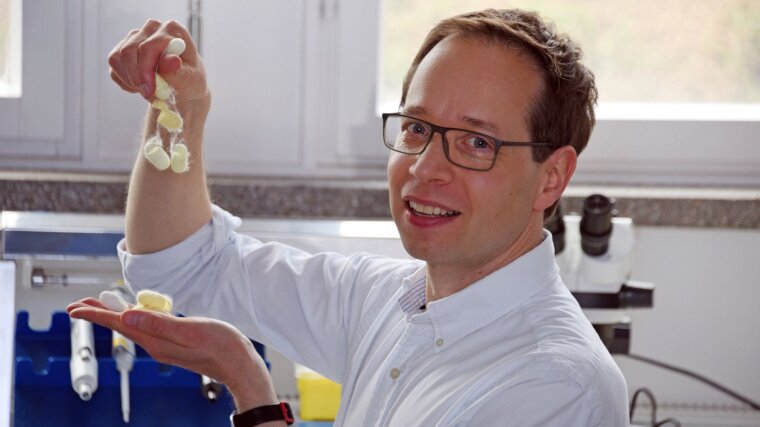
- Life
Published: | By: Stephan Laudien
Source article
The silkworm (Bombyx mori) and related species are among the oldest pets of mankind. The fascinating ability of these insects to spin a thread hundreds of metres long has been used for around 5,000 years. This thread is spun into a cocoon in whose protective shell the caterpillar can pupate undisturbed. Obtained by humans, the fine threads form the basis of fine fabrics and garments. However, in recent years, other properties of silk have come into focus. It is used in Medicine to cover wounds or close surgical incisions. "Silk has enormous potential for a wide range of other applications," says Prof. Dr Philipp Seib, Professor of Pharmaceutical Technology and Biopharmacy at Friedrich Schiller University since 2023. He has been researching the fascinating natural substance silk since 2009. Seib's goals: To understand which biochemical processes take place while the silkworm spins and processes its thread in peace and quiet and to master these processes in order to create customised solutions for further Medicine applications. But there is still a long way to go before we get there.
Silk can be used in a variety of ways and is good for surprises
"We can say that silkworms are currently around 1,000 times more efficient than weare," notes Philipp Seib. With amazingly simple "ingredients", these insects are able to produce a thread of fascinating strength that hardens immediately after leaving the spinning glands. Water is the only solvent, says Seib. In addition, the spinnerets do not stick together despite minimal energy input. If these abilities could be copied, new types of threads or - better - 3D printing processes for Medicine could be developed. Another idea is to coat nano-sized drugs with silk so that they can be delivered to the body in a targeted manner. "The advantage of silk is that it is biocompatible and biodegradable and therefore does not accumulate in the body," explains Philipp Seib. There are also always surprises. For example, a frozen silk thread is more resistant to mechanical stress than a thread at normal temperature. Some of the solutions to the silk puzzle can only be found if the gene sequences are read out. This is also the key to being able to produce new biopolymers. Philipp Seib confirms that much of this is still basic research, but in co-operation with the University Hospital, concrete applications are already being worked on in parallel.
Pharmacy as an interface between Biology and Chemistry
After leaving school in England, Philipp Seib studied at King's College in London. He was interested in Chemistry and Biology from an early age, so it made sense for him to study Pharmacy. "The subject lies at the interface between the two disciplines," says Philipp Seib. His first stop after completing his doctorate on nanomedicine and its intracellular distribution at Cardiff University in Wales was the Leibniz Institute of Polymer Research in Dresden. From there he went to Tufts University in Boston (USA). Philipp Seib then spent over ten years conducting research in Glasgow, Scotland, before deciding in favour of Jena. "Here we have a great opportunity to build something new," enthuses Seib. This includes good teaching and joint research on an equal footing: "A team develops the best ideas through direct professional exchange, so there shouldn't be any barriers," says Seib.
In his free time, Philipp Seib enjoys sports, swimming and hiking. He is also interested in architecture. In his private life: He enjoys spending time with his family.